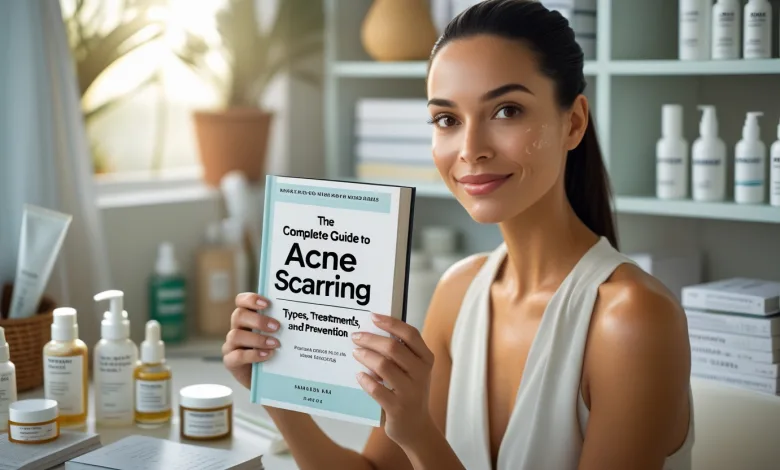The Complete Guide to Acne Scarring: Types, Treatments, and Prevention

Acne scars can be stubborn reminders of past breakouts, but understanding their types and available treatments can help you reclaim your confidence. This comprehensive guide explores everything from the science behind acne scarring to cutting-edge treatments and prevention strategies.
Understanding Acne Scarring: What’s Actually Happening to Your Skin?
Acne scarring occurs when the healing process following a breakout goes a bit haywire. When your skin experiences inflammation from acne, it triggers a cascade of healing mechanisms. Sometimes, these mechanisms don’t work perfectly, leading to either excess or insufficient tissue formation.
The journey from a pimple to a scar isn’t inevitable, though. Your skin’s response to acne inflammation depends on several factors, including genetics, the severity of the acne, and how you’ve handled the breakouts. Ever noticed how some people can have severe acne but minimal scarring, while others develop noticeable scars from relatively minor breakouts? That’s your genetic predisposition at play. According to a 2017 study in the Journal of Clinical and Aesthetic Dermatology, approximately 40% of people with acne will develop some degree of scarring, with genetics playing a significant role in determining who’s more vulnerable.
Types of Acne Scars: Not All Scars Are Created Equal
When it comes to acne scarring, one size definitely doesn’t fit all. Understanding the type of scar you’re dealing with is crucial for finding the right treatment approach. Let’s break down the main categories:
Atrophic Scars (Depressed Scars)
These are the most common type of acne scars and appear as indentations in the skin. They occur when there’s not enough collagen production during the healing process. Within this category, you’ll find:
- Ice pick scars: These are deep, narrow punctures that look like tiny round or oval holes, as if the skin was pierced with an ice pick. They’re often the toughest to treat because they extend deep into the dermis.
- Boxcar scars: Wider than ice pick scars, these have sharp edges and look like round or oval depressions with steep sides. They resemble the scars left by chickenpox and typically affect the temple and cheeks.
- Rolling scars: These create a wave-like appearance on otherwise normal-looking skin. They’re formed when fibrous bands of tissue develop between the skin and the subcutaneous tissue below, pulling the epidermis down in certain spots.
Hypertrophic and Keloid Scars (Raised Scars)
These occur when the body produces too much collagen during healing, resulting in a raised appearance. Hypertrophic scars stay within the boundary of the original wound, while keloid scars extend beyond it. According to the American Academy of Dermatology, these are more common in people with darker skin tones and tend to appear on the chest, back, shoulders, and jawline.
Post-Inflammatory Hyperpigmentation (PIH)
Strictly speaking, these aren’t true scars but rather discolored patches left behind after acne heals. They’re especially common in people with darker skin tones. PIH typically fades over time, though it can take months or even years without treatment. Research published in The Journal of Clinical and Aesthetic Dermatology indicates that up to 65% of people with acne experience some degree of PIH.
Assessing Your Acne Scars: How Serious Is Your Situation?
Before diving into treatment options, it’s important to accurately assess your scars. This isn’t just about looking in the mirror and feeling frustrated—it’s about understanding the severity of your scarring so you can pursue appropriate solutions.
Many dermatologists use the Goodman and Baron Qualitative Scarring Grading System, which categorizes scars from Grade 1 (macular or mild) to Grade 4 (severe). A proper assessment from a dermatologist can help determine which treatments might work best for your specific situation. Remember, what works for your friend’s rolling scars might not be effective for your ice pick scars.
During your assessment, your dermatologist will also consider factors like your skin type, age, and overall health. For instance, darker skin tones require more careful approach to prevent post-inflammatory hyperpigmentation from treatments themselves. Don’t skip this crucial step—a proper evaluation can save you time, money, and potential disappointment down the road.
Treatment Options: From Home Remedies to High-Tech Solutions
Treating acne scars has come a long way from just “living with it.” Today’s options range from over-the-counter products to advanced dermatological procedures. Let’s explore the spectrum of treatments available:
Topical Treatments
For milder scarring and PIH, topical treatments can be remarkably effective:
- Retinoids: These vitamin A derivatives promote cell turnover and collagen production. According to a study in the American Journal of Clinical Dermatology, retinoids can improve the appearance of both acne and resulting scars.
- Vitamin C serums: Known for their brightening properties, vitamin C products can help fade discoloration and promote collagen synthesis.
- Alpha hydroxy acids (AHAs): These exfoliating acids, like glycolic acid, can help reduce the appearance of superficial scarring by removing dead skin cells and promoting new cell growth.
- Niacinamide: This form of vitamin B3 can help reduce inflammation and hyperpigmentation while supporting the skin barrier.
Professional Treatments
For moderate to severe scarring, professional treatments offer more dramatic results:
Chemical Peels
Chemical peels involve applying a chemical solution to remove the outer layers of skin, promoting new skin growth. The American Society for Dermatologic Surgery reports that chemical peels can be particularly effective for rolling scars and superficial boxcar scars. The depth of the peel determines both results and recovery time—deeper peels yield more dramatic results but require longer healing periods.
Microdermabrasion and Dermabrasion
These procedures physically remove the top layers of the skin. Microdermabrasion is gentler and works best for very mild scarring, while dermabrasion is more aggressive and can address deeper scars. A review in the International Journal of Dermatology found that dermabrasion could improve the appearance of scars by up to 50% in appropriate candidates.
Microneedling
This treatment uses a device covered in tiny needles to create controlled micro-injuries, stimulating collagen production. Studies published in the Journal of Cutaneous and Aesthetic Surgery show that microneedling can improve acne scars by up to 31% after just three sessions.
Laser Treatments
Laser therapies use focused light to remove damaged skin and stimulate collagen production. Different types include:
- Fractional laser therapy: Creates thousands of microscopic treatment zones, leaving surrounding tissue intact for faster healing.
- CO2 laser resurfacing: More aggressive but highly effective for deeper scars.
- Pulsed dye laser: Particularly effective for red or raised scars.
According to the American Academy of Dermatology, multiple laser sessions are typically needed, spaced 3-4 weeks apart.
Dermal Fillers
For atrophic scars, dermal fillers can be injected beneath the scar to raise the depressed area. While not permanent, fillers can provide immediate improvement. Hyaluronic acid fillers typically last 6-18 months, while longer-lasting options like poly-L-lactic acid can stimulate collagen production for more permanent results.
Subcision
This minor surgical procedure involves inserting a needle beneath the skin to break up fibrous bands that pull down on the skin’s surface, particularly effective for rolling scars. A study in Dermatologic Surgery found that subcision could improve rolling scars by up to 50%.
Prevention: Stopping New Scars Before They Form
An ounce of prevention is worth a pound of cure—especially when it comes to acne scarring. Here’s how to minimize your risk of developing new scars:
Treat Acne Promptly and Properly
The most effective way to prevent acne scars is to treat active acne quickly and effectively. The longer and more severe an inflammatory acne lesion is, the more likely it is to leave a scar. According to the American Academy of Dermatology, early intervention can significantly reduce scarring risk.
Working with a dermatologist to develop an effective acne treatment plan should be your first step. This might include:
- Topical treatments (retinoids, benzoyl peroxide, antibiotics)
- Oral medications (antibiotics, hormonal treatments, isotretinoin for severe cases)
- Procedures like chemical peels or light therapy
Hands Off!
It’s tempting to pick, pop, or squeeze acne lesions, but this dramatically increases scarring risk. Picking introduces bacteria and pushes inflammation deeper into the skin, often making a minor breakout into a scar-leaving situation. Make a commitment to keep your hands off your face—your future skin will thank you.
Sun Protection
Exposure to UV rays can darken acne scars and hyperpigmentation, making them more noticeable and longer-lasting. Daily sunscreen use is non-negotiable for anyone concerned about acne scarring. Choose a broad-spectrum SPF 30+ that’s labeled “non-comedogenic” to avoid triggering new breakouts.
Early Intervention for New Scars
If you notice a new scar forming, early treatment can help minimize its appearance. Silicone gel sheets, pressure treatments, and early use of topical treatments like retinoids can all help modify the scarring process while it’s still active.
The Psychological Impact: Dealing with the Emotional Side of Scarring
Acne scarring isn’t just a physical concern—it can take a significant emotional toll as well. Research published in the British Journal of Dermatology found that the psychological impact of acne scarring can be comparable to that of chronic conditions like psoriasis and vitiligo.
If you’re struggling with the emotional aspects of acne scarring, consider:
- Speaking with a mental health professional who specializes in body image issues
- Joining support groups (online or in-person) for people with similar concerns
- Practicing self-compassion and positive self-talk
- Learning makeup techniques that can help camouflage scars if desired
Remember, seeking help for the emotional impact is just as important as treating the physical scars themselves.
Natural Approaches: Can Home Remedies Help?
While professional treatments often yield the most dramatic results, some natural approaches may help improve mild scarring or complement professional treatments:
Honey and Cinnamon Masks
Raw honey has antimicrobial properties that can help with active acne, while cinnamon may help increase blood flow to the skin surface. A study in the Journal of Cosmetic Dermatology found that honey can promote wound healing and tissue regeneration.
Aloe Vera
Known for its soothing properties, aloe vera may help reduce inflammation and promote healing. Research published in the Annals of Plastic Surgery suggests that aloe can improve wound healing and reduce scar formation.
Rosehip Seed Oil
Rich in vitamins A and C, rosehip seed oil may help improve skin texture and reduce hyperpigmentation. A study in the Journal of Cosmetics, Dermatological Sciences and Applications found that rosehip oil improved the appearance of post-surgical scars.
While these natural remedies may offer some benefits, it’s important to maintain realistic expectations and consult with a dermatologist before trying any new treatment.
FAQs About Acne Scarring
How long does it take for acne scars to fade naturally?
Post-inflammatory hyperpigmentation may fade naturally over 3-24 months, depending on your skin tone and the severity of the discoloration. True atrophic or hypertrophic scars, however, are permanent changes in the skin’s structure and typically won’t fade completely without intervention.
Can acne scars be completely removed?
While complete removal isn’t always possible, significant improvement can be achieved with appropriate treatments. The degree of improvement depends on the type and severity of scarring, your skin type, and your body’s healing response. Multiple treatment approaches may be needed for optimal results.
Are some people more prone to acne scarring than others?
Yes! Genetic factors play a significant role in determining who develops scars. Other risk factors include having inflammatory acne (especially nodules and cysts), delayed or inappropriate treatment of acne, and picking or squeezing acne lesions.
Does health insurance cover acne scar treatments?
Most insurance plans consider acne scar treatment to be cosmetic and don’t provide coverage. However, there are exceptions, particularly if the scarring causes functional issues or resulted from severe cystic acne. Always check with your insurance provider and dermatologist about potential coverage.
How do I know which treatment is right for my scars?
The best treatment depends on your scar type, skin type, budget, and downtime tolerance. A board-certified dermatologist can evaluate your scars and recommend the most appropriate options for your specific situation.
Final Thoughts: Your Journey to Clearer Skin
Living with acne scars can be challenging, but today’s advanced treatments offer hope and real results. The complete guide to acne scarring isn’t just about understanding your options—it’s about empowering yourself to take control of your skin’s health and appearance.
Remember that treating acne scars often requires patience and consistency. Most treatments show gradual improvement over multiple sessions, and combining approaches often yields the best results. Work closely with a qualified dermatologist to develop a customized treatment plan that addresses your specific concerns and fits your lifestyle.
Whether you’re dealing with rolling scars, ice pick scars, or post-inflammatory hyperpigmentation, there’s a solution out there that can help. The journey to clearer skin begins with understanding your scars and taking that first step toward treatment.






